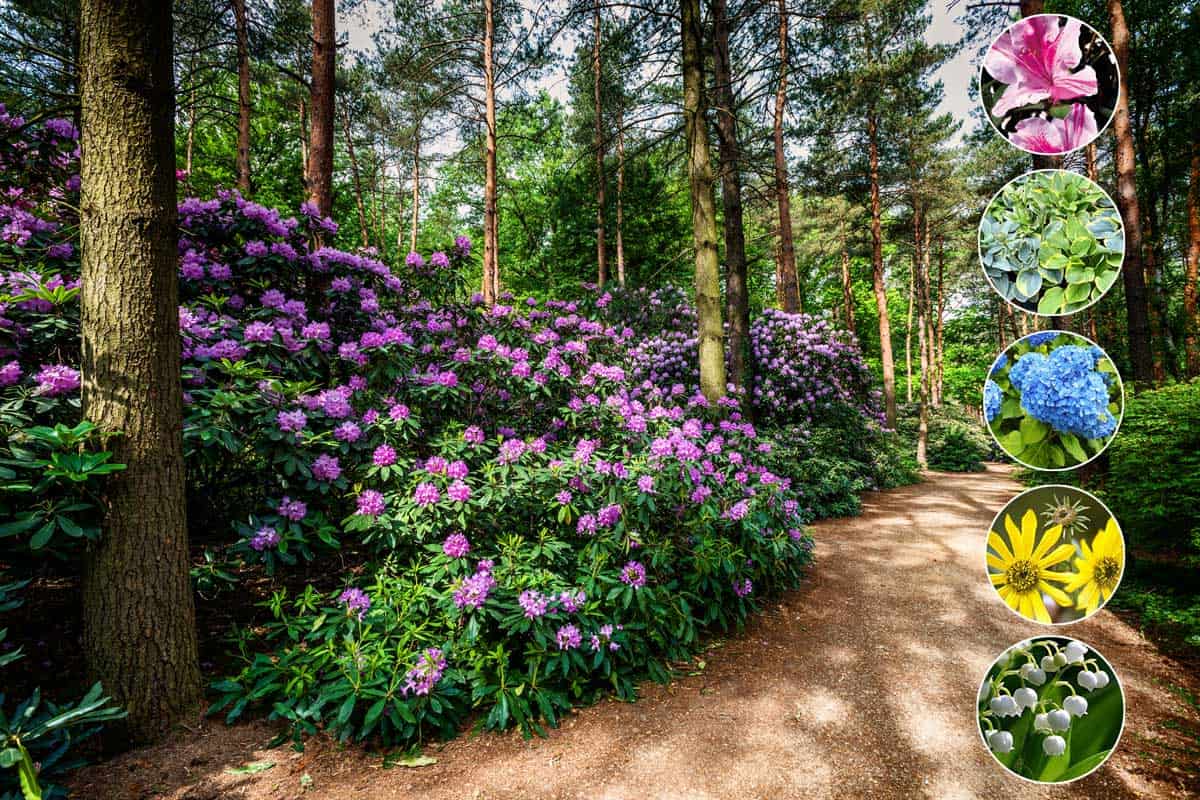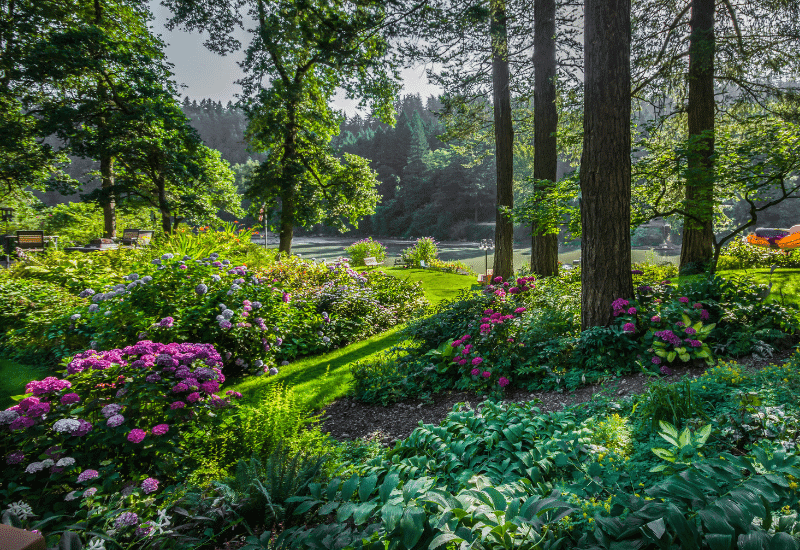
The density of the forest canopy determines whether you can plant hydrangeas below pine trees. The hydrangea will not receive sunlight or rain if the canopy is too dense. If you water hydrangeas consistently and modify the soil, you should be able to grow them if the canopy allows for some dappled light.
To ensure that your hydrangeas not only live but thrive and produce lovely blooms, there are a few more factors that you must first get correct if you have a pine tree that enables partial shade or dappled light to reach the area where you wish to grow them.
Table of Contents
Soil and watering Under Pine Trees
Finding a clear piece of soil to plant in is the first and most crucial challenge since pine trees have a deep and broad root system. If the tree is an ancient, well-established pine, you can use an axe to cut out a few roots without harming the tree in the long run.
As a landscape gardener, I’ve had to cut out parts of roots numerous times, but the trees never seem to mind.
After finding a spot, the next consideration is…
pH of the soil: Because pine trees require acidic soil and because the soil under pine trees is likely made up of many generations’ worth of decayed, mulched-down pine needles, which are likewise slightly acidic or pH neutral, the pH of the soil under pine trees will be naturally acidic.
While pine needles are highly acidic when they fall from the tree, the ensuing organic matter is either slightly acidic or pH neutral after they have decomposed, therefore pine needles will have less of an impact on soil pH than most people think.
Fortunately, hydrangeas thrive in acidic soil, and if they are of the species Hydrangea macrophylla, their blossoms will be blue (Bigleaf hydrangeas). Although it might be challenging to get the pH of the soil quite right, you can make hydrangea flowers become pink by adding lime or wood ash, both of which have an alkaline pH.
Soil composition: Growing hydrangeas in the soil composition beneath a pine tree will not be perfect, but you can improve the conditions by making a few changes.
You must fill the planting area with a lot of organic matter, ideally to a depth of over 6 inches and a breadth large enough to fit the root system of your hydrangea when it is fully grown.
Farm manure, leaf mold, or regular garden compost are all excellent choices because they are excellent at retaining moisture and allowing for proper drainage so that water doesn’t accumulate or pool around the roots.
Additionally, they will apply fertilizer and keep the pH of the soil at about 6-7. You must add this organic material because the main cause of hydrangea deaths is their inability to absorb adequate water from the soil.
Compost and other organic materials will assist in preserving the ideal moisture balance in the soil that hydrangeas love.
Mulching helps Retain Water Under Dry Pine Trees
Regular mulching will be beneficial for hydrangeas that are sheltered from moisture by pine trees.
Put a 2 inch layer of mulch on the hydrangea’s surrounding soil.
The hydrangea’s woody stems should be kept 6 inches away from the mulch since they dislike being exposed to persistently moist substances.
Mulch will enhance the soil’s texture and hold onto water, keeping the soil beneath it at the ideal moisture level for plant roots. Additionally, there are the following advantages:
- Nutrient addition to the soil
- stimulating the beneficial ecosystem of the soil
- halting the growth of weeds
The first few days after planting are crucial for mulching around hydrangeas because this is when the plant is most susceptible to drought.
The finest mulching materials for dry climates are compost, manure, and leaf mold because they have the best ability for keeping moisture while yet having a structure that allows for adequate drainage—perfect for hydrangeas.
Watering Hydrangeas Under Pine Trees

Pine trees can restrict the availability of water from\srainfall by:
- catching the rain in the canopy to prevent it from falling on the ground below
- With their broad and thirsty root systems, pine trees can absorb all the soil moisture, reducing the amount of moisture that is available for your hydrangea.
This means that because hydrangeas are thirsty plants, regular watering is necessary in the spring and summer.
Being under a pine tree has the advantage of providing substantial shade, which will prevent the soil from drying out too rapidly.
Using a soaker hose watering system, which can release water gradually even during the warmest summer days, is the greatest approach to maintain the ideal soil moisture for hydrangeas.
If that is not possible, then during the growing season, I advise giving your hydrangea about 2 gallons of water once every two or three days. You must increase the frequency of your watering if the surrounding soil is dry to a depth of just a few fingers. The soil has to be moist. I would suggest drinking water every other day throughout the hottest parts of the summer.
This may seem like a lot of water, but keep in mind that the roots of the pine and those of the hydrangea will be vying for moisture, so it’s necessary to check soil moisture and make adjustments for the weather.
Your hydrangea shouldn’t require any more hydration over the Winter as it enters its dormant stage.
Is There Enough Light for Hydrangeas?
In full shadow, hydrangeas will struggle to establish themselves and, even if they do, they won’t reach their full potential and blossom profusely.
If your pine tree completely shades the area where you wish to plant hydrangeas, you might want to strategically prune back branches to let more light through. The best time to pollard established pine trees is during the winter, though they will tolerate minimal branch trimming at any time of year.
All species of hydrangeas do best in the morning sun with afternoon shade. Although they can thrive in full light, some shade is desirable because it reduces the rate of soil development.
As long as the soil has been richly fertilized with organic matter, the dappled light that your pine tree consistently casts on the ground below will be sufficient to support the growth of hydrangeas.
The species of hydrangea that thrives in the shadow is Big Leaf Hydrangea.
The Best Hydrangeas
for Growing Under Pine Trees
There are various cultivars of this species that yield lovely blooms in a variety of colors to suit your preferences. In addition, they generate notable lush foliage (as the name implies) that is attractive even when the hydrangea is not in bloom.
Even in the shade and in dappled light, bigleaf hydrangeas will bloom, but the better the show, the more sunlight it will get.
– Azaleas.Right after planting, when the plant is most susceptible to drought, it is crucial to provide mulch to the area around hydrangeas.
Compost, manure, and leaf mold are the ideal materials for dry circumstances as they have the best ability for keeping moisture while still having a structure that allows for adequate drainage—perfect for hydrangeas. Mulching can be done with a variety of materials.
Making certain that plants beneath pine trees receive enough water presents one of the toughest concerns.
When it rains, pine trees can reduce the amount of water that is available by:
Rain is caught in the canopy, preventing it from soaking the ground below
The amount of moisture that is available for your hydrangea can be lowered by pine trees because of their large and thirsty root systems.
In light of the fact that hydrangeas are thirsty plants, regular watering is important during the spring and summer.
A pine tree will provide plenty of shade, which will prevent the soil from drying out too rapidly. This is the saving grace of being under one.
Using a soaker hose watering system, which can release water gradually even during the hottest summer days, is the greatest approach to keep hydrangeas’ soil at the ideal moisture level.
If that isn’t possible, then during the growing season I advise watering your hydrangea once every two to three days with about 2 gallons of water. In order for the soil to stay moist, you must water more frequently if the soil is dry to a depth of just a few fingers around the plants. Water should be consumed every other day throughout the warmest parts of the summer.
This may seem like a lot of water, but keep in mind that the roots of the pine will be vying with those of the hydrangea for moisture, so it’s crucial to monitor the moisture of your soil and make adjustments for the weather.
As it transitions into its Winter hibernation, your hydrangea shouldn’t require any extra watering over the Winter.
Even if they are able to establish themselves, hydrangeas will struggle to reach their full potential and produce an abundance of flowers under complete shadow.
I might strategically remove branches to allow light in if your pine tree completely shades the area where you wish to plant hydrangeas. Although pollarding (branch cutting) can be done at any time of year on established pine trees, winter is the best time to carry it out.
Every species of hydrangea benefits from morning sun with afternoon shade. Although they can grow in direct sunlight, some shade is recommended because it reduces the rate at which soil ages.
